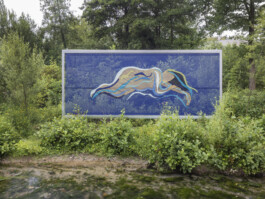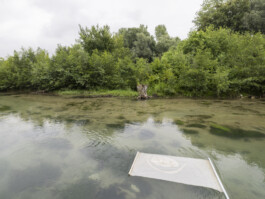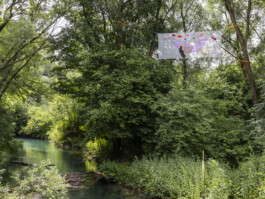I want to lay down with you, 2025



Installation views: Hanna Neander
What does it mean to rest in nature, along the Pader? Along the river, which today serves as a green oasis and a place for recreation in the middle of the city, the artist asks this question in her series I want to lay down with you. Three textile paintings refer to places of rest – the outer source area, the newly created Padersee floodplain and the grounds of the 1994 garden exhibition. These places of relaxation were, until a few
decades ago, characterised by mills and industries that used a lot of water, such as flax cultivation, tanneries and breweries – places of work and a burden for the river.
The figures in the textiles are at rest. They seem heavy but not burdened – rather present, in harmony with themselves and their surroundings. But who is at rest here? Is it the river itself as a personified being? Or do the images show a human longing: to flow with the river, to lie in a hammock between trees, surrounded by pink flowers? Or are we simply listening
to the water here – without expectation, without task?
Rest is a physical necessity – and yet not equally accessible to everyone. Particularly marginalised groups, refugees, precarious workers or those in care work often experience the opposite – for them, rest is a rare or unattainable state. The artwork invites us to not view rest as a luxury, but as an essential part of care, community and equality – even towards nature.
← back
I want to lay down with you, 2025



Installation views: Hanna Neander
What does it mean to rest in nature, along the Pader? Along the river, which today serves as a green oasis and a place for recreation in the middle of the city, the artist asks this question in her series I want to lay down with you. Three textile paintings refer to places of rest – the outer source area, the newly created Padersee floodplain and the grounds of the 1994 garden exhibition. These places of relaxation were, until a few
decades ago, characterised by mills and industries that used a lot of water, such as flax cultivation, tanneries and breweries – places of work and a burden for the river.
The figures in the textiles are at rest. They seem heavy but not burdened – rather present, in harmony with themselves and their surroundings. But who is at rest here? Is it the river itself as a personified being? Or do the images show a human longing: to flow with the river, to lie in a hammock between trees, surrounded by pink flowers? Or are we simply listening
to the water here – without expectation, without task?
Rest is a physical necessity – and yet not equally accessible to everyone. Particularly marginalised groups, refugees, precarious workers or those in care work often experience the opposite – for them, rest is a rare or unattainable state. The artwork invites us to not view rest as a luxury, but as an essential part of care, community and equality – even towards nature.
← back